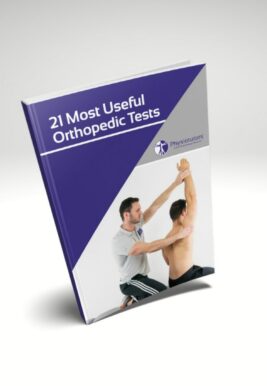Learn
Greater Trochanter Palpation | Gluteal Tendinopathy (GTPS)
Gluteal tendinopathy which falls under the nowadays used umbrella term greater trochanteric pain syndrome or GTPS is part of the differential diagnosis in patients with lateral hip pain.
Grimaldi et al. (2016) conducted a diagnostic accuracy study on different diagnostic tests that were contrasted to MRI findings indicative of gluteal tendinopathy. Palpation had a sensitivity of 80% and a specificity of 46,7%. This was the most sensitive test in the study and due to its negative likelihood ratio of 0.43, we give it a moderate clinical value in excluding gluteal tendinopathy.
Grimaldi et al. (2016) reference an article by Falvey et al. (2008) that describes a systematic approach to palpation of the structures around the greater trochanter. Viewing the greater trochanter as a ‘‘clock face’’, the muscles insert as follows: gluteus medius and its underlying bursa at 12, gluteus minimus and its underlying bursa at 1, gluteus maximus overlaps the area to insert from 2 to 6 with the vastus lateralis arising outside this. The Quadratus femoris insert between 7 and 8, the conjoint tendon of the gemelli and obturator internus at 8–10 and the rounded tendon of piriformis at 10–11.
The patient is going to lie on the unaffected side with the hips flexed to around sixty degrees and the knees together. Then proceed to palpate the structures around the greater trochanter and look for the reproduction of the patient’s lateral hip pain with palpation of the gluteus medius and or gluteus minimus tendon insertions. Pain felt should be at least 2/10 on the NPRS.
21 OF THE MOST USEFUL ORTHOPAEDIC TESTS IN CLINICAL PRACTICE

Other orthopedic tests that assess for gluteal tendinopathy are:
- Resisted External Derotation Test
- Single Leg Stance Test
- FADER / FADER-R / Modified Resisted External Derotation Test
- ADD / ADD-R/ Modified Ober’s Test
References
Like what you’re learning?
BUY THE FULL PHYSIOTUTORS ASSESSMENT BOOK
- 600+ Pages e-Book
- Interactive Content (Direct Video Demonstration, PubMed articles)
- Statistical Values for all Special Tests from the latest research
- Available in 🇬🇧 🇩🇪 🇫🇷 🇪🇸 🇮🇹 🇵🇹 🇹🇷
- And much more!








